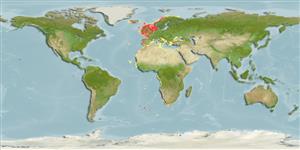Common names from other countries
Environment: milieu / climate zone / depth range / distribution range
Ekologi
; payau; kisaran kedalaman 0 - 200 m (Ref. 435), usually 6 - 40 m (Ref. 435). Temperate, preferred 12°C (Ref. 107945)
Eastern Atlantic and the Mediterranean: from northwest Morocco to Atlantic coast of Europe.
Length at first maturity / Size / Weight / umur
Maturity: Lm 11.0 range ? - ? cm Max length : 20.0 cm CL jantan/; (Ref. 435)
This is the most important edible crab fishery in Europe (Ref. 2762). Maximum depth from Ref. 106870. Occurs from the intertidal area to a depth of 100 m, common at depths 6 to 40 m (Ref. 435). Regularly found just above low tide mark. Found in an estuary (Ref. 106870). Inhabits rocky or sandy bottom (Ref. 96377). Carnivore; trophic level 3.1 (Ref. 96418).
Members of the order Decapoda are mostly gonochoric. Mating behavior: Precopulatory courtship ritual is common (through olfactory and tactile cues); usually indirect sperm transfer.
rujukan utama
Acuan | Koordinator | mitra
Fischer, W., G. Bianchi and W.B. Scott (eds.). 1981. (Ref. 435)
Status IUCN Red List (Ref. 130435)
status CITES (Ref. 108899)
Not Evaluated
Not Evaluated
penggunaan manusia
Perikanan: komersial
FAO - Perikanan: landings, profail spesis | FishSource | Sea Around Us
Alat, peralatan
Sumber internet
Estimates based on models
Preferred temperature
(Ref.
115969): 8.1 - 12.5, mean 10.4 (based on 518 cells).
Daya lenting
Tinggi, Waktu penggandaan populasi minimum kurang dari 15 bulan (K=0.24-0.46).
Prior r = 0.46, 95% CL = 0.31 - 0.69, Based on 2 data-limited stock assessments.
keancaman
Low vulnerability (10 of 100).
